There are years that are considered landmarks in comic book history. 1938, with the debut of Superman and the birth of a new genre. The early 1960s, when Marvel revolutionized the superhero with characters like the Fantastic Four, Spider-Man, the Hulk, and the X-Men. The 1980s, when creators pushed the boundaries of what was expected and accepted from superhero comics (not just for kids anymore, as they say).
Me? I like 1994.
The 1990s are generally considered a comics landmark in the negative sense. Though sales hit a high point early in the decade, this was largely due to rampant speculation and the many gimmicks (holographic variant covers, anyone?) meant to fuel that frenzy. Though Readers of a Certain Age may look back on the decade with semi-fond nostalgia, it’s mostly remembered for massive, grimacing heroes with flowing ponytails and questionable anatomy, wielding gun-swords and covered in pouches. So many pouches.
1994 isn’t immune to this. A glance at Wikipedia’s list of 1994 debuts reveals both Archie Meets Punisher and Spawn/Batman, a combination (well, a combination of combinations) that certainly evokes a particular…flavor.
But it also includes more than half a dozen new DC characters I absolutely love, plus the launch of one of the best comics…ever? So this January, as we’re ringing in the 30th anniversary of these heroes, I thought I’d do a rundown of DC’s class of ‘94, a.k.a. The Year of the Mandatory Center Part, and show you what Gen X was reading while drinking Surge and playing Pogs.
Artemis of Bana-Mighdall
|
|
Created by William Messner-Loebs and Mike Deodato, Artemis was introduced as a potential rival to Wonder Woman. She actually took over the “Wonder Woman” title briefly when Diana’s mother, Queen Hippolyta, declared that Diana had been inadequate in the role, although this was mostly because Hippolyta had had a vision of Wonder Woman dying and wanted it to be someone who wasn’t her kid. (Artemis did die. She got better.)
Artemis has mostly stuck with the Wonder Woman books since her debut, although she did do a stint on the 2016 volume of Red Hood and the Outlaws (and appears in the Webtoon of the same name). I prefer to see her getting messy with Amazonian politics over playing love interest to Jason Todd, but mostly, I just love seeing a female character who doesn’t care one tiny bit about being pleasant.
CENTER PART? Somehow, yes, despite the fact that she always wears a high ponytail.
Damage
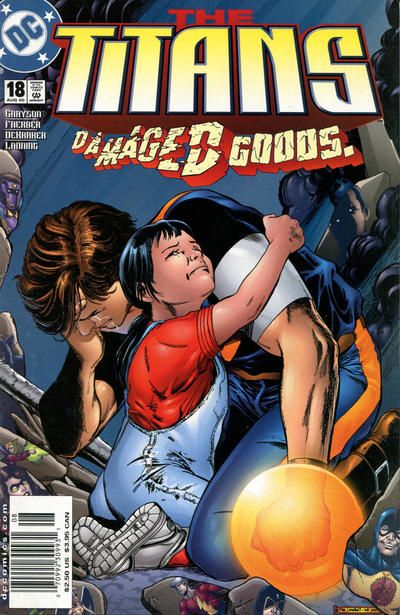 |
Damage, a.k.a. Grant Emerson, debuted in his own self-titled series and was created by Tom Joyner and Bill Marimon. He quickly joined the Titans, teamed up with the Justice League, and restarted the universe in the company-wide crossover Zero Hour, so it’s weird that he’s still a fairly obscure character.
If you like Spider-Man for the “angsty teen whose life is a series of escalating disasters” factor, you’re gonna love Grant. He was kidnapped from his real parents (the Golden Age Atom and his wife) at birth by shady scientists, and things only got worse from there. Even getting superpowers didn’t help, since his main power is blowing things up uncontrollably when he gets mad, and he gets mad a lot. Grant’s solo series is admittedly mostly unreadable, but his stints on the 1999 Titans and the 2007 Justice Society of America made me fall in love with him. I will follow this boy forever, hoping for at least one (1) good thing to happen to him, ever.
CENTER PART? Eventually.
Green Arrow (Connor Hawke)
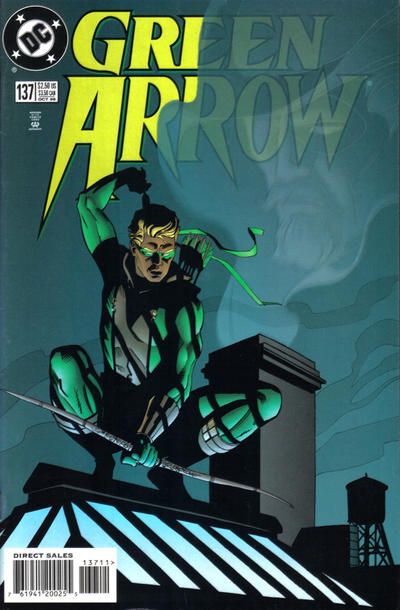 |
If the ’90s were about anything for DC besides pouches, they were about legacy and a fascination with their own history that embraced tradition even as it rejected the old in favor of the new and hip. Classic characters were killed off or retired and replaced with younger, sexier models in an attempt to speak to Gen X readers. Connor Hawke, created by Kelley Pucket and Jim Aparo, isn’t the poster child for this trend, but he’s up there.
The son of and successor to the original Green Arrow, Oliver Queen, Connor is everything his hot-tempered, loudmouthed father isn’t: a thoughtful, sensitive, multiracial Buddhist monk who avoids fights instead of picking them. He’s a breath of fresh air among the histrionic superheroes he’s surrounded by, and I was livid when the New 52 erased him from existence. Thankfully, he’s now back in action with the rest of his family*, and even recently came out as asexual, something fans had been asking for for ages.
*Are you reading the current Green Arrow book? You should be reading the current Green Arrow book.
CENTER PART? No, but his head is shaved completely bald when he’s first introduced, so I’ll allow it.
Green Lantern (Kyle Rayner)
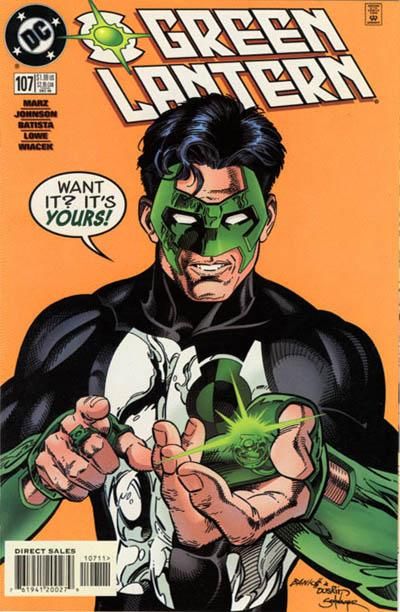 |
Now, this is the poster child for new hip ’90s replacements! When longtime Green Lantern Hal Jordan was driven to insanity and cosmic-level supervillainy by trauma, aspiring artist Kyle Rayner (created by Ron Marz and Darryl Banks) was picked at random to replace him. He remained the universe’s only Green Lantern (when once there had been a 3,600-strong Green Lantern Corps) for nearly a decade.
Hal’s heel turn and Kyle’s debut were so controversial they spawned the creation of H.E.A.T. (Hal’s Emerald Alliance Team), an “activist” group dedicated to restoring their boy to glory, via furious harassment if necessary. To this day, there are people who have spent the past 30 years hating Kyle and will continue to hate him for the next 30. A lot of their anger seems to have come from the fact that Kyle wasn’t anyone’s protege or son — he was literally Just Some Guy. (But not this Guy.) To me, that’s what makes him so emblematic of the decade. When we first meet him, he’s an underachieving slacker, a sensitive Gen X creative with zero link to Hal’s all-American 1950s masculinity, neither ambitious nor laden with destiny. It’s the way he grows into the responsibility that fell into his lap that makes him such an engaging hero to read.
CENTER PART? Oh, you better believe it.
Impulse
 |
Created by Mark Waid and Mike Wieringo, Bart Allen is the grandson of the Silver Age (and in 1994, very dead) Flash, Barry Allen. Born in the 30th century, Bart was raised in virtual reality until he was brought back to the 20th century by his cousin and the current Flash, Wally West, to learn how to control his super speed. Bart’s another poster child for the ’90s’ simultaneous fascination with and rejection of legacy. Yes, he’s related to two different Flashes and mentored by a Golden Age speedster, Max Mercury, and everyone in his life, Bart included, fully embraces his destiny as a future Flash. But he’s not Kid Flash. He’s Impulse.
Like so many on this list, Bart has largely been sidelined in recent years, but his original solo series was the first comic I fell in love with and remains one of my all-time favorites to this day. (His time on the team book Young Justice is also excellent.) If you are looking for a comic that is funny, all-ages, heartwarming, and occasionally heartbreaking, and — dare I say it? — fast-paced, I recommend tracking Impulse down.
CENTER PART? Everything about Bart’s hair is glorious and that includes his center part.
Koryak
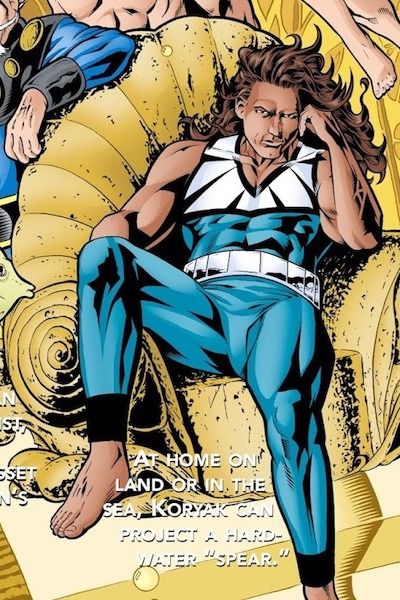 |
Absolutely the most obscure character on this list, Koryak was created by Peter David and Jim Caliafore and is the illegitimate son of Aquaman and an Inuit woman named Kako. Like Connor Hawke, Koryak reached young adulthood before his father learned of his existence, at which point Koryak quickly became embroiled in the messiness of Atlantean politics. He was all but written out of the book by the 2000s, but he came back a few years later to die, be resurrected with amnesia (and dreadlocks, for some reason?), murder his father (he got better), and be retconned out by the New 52. So there’s that.
Koryak is self-centered, petty, vindictive, and nakedly clumsily ambitious, which is probably why so far he hasn’t been popular enough to bring back. It’s also why I love him, because all of those negative qualities make him wildly entertaining to read — and hey, maybe if Aquaman wasn’t arguably the worst superhero father in the DCU, Koryak would be more socially ept. (Yes, Aquaman is even worse than Batman.) Maybe his 30th anniversary is the time for Koryak’s glorious return? Please?
CENTER PART? When his hair isn’t billowing around his head Little Mermaid-style, yes.
Starman (Jack Knight)
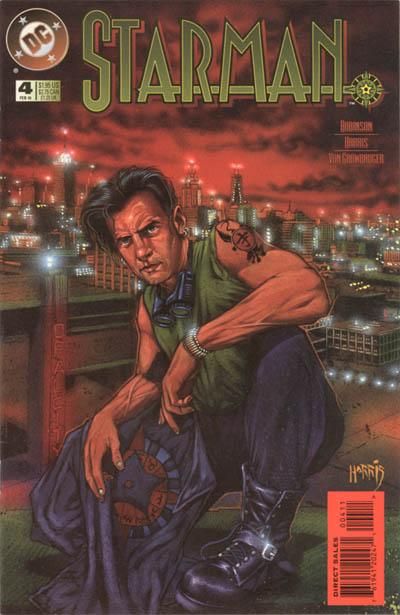 |
By now, you will not be the slightest bit surprised to learn that Jack is the son of a superhero — specifically, Ted Knight, the Golden Age Starman. Created by James Robinson and Tony Harris, Jack starred (ha!) in his own long-running series, wherein he reluctantly takes up the mantle of Starman after his older brother David’s murder.
Like Kyle, Jack is quintessentially Gen X, eschewing the earnest, try-hard bright colors of superheroics in favor of a beat-up leather jacket and a disaffected attitude. But Starman (1994) is the slowly unfolding story of a man who, beneath his apathetic exterior, deeply loves his city, his father, and the legacy he has inherited. Impulse is my favorite book on this list, but if you only read one of the books here, make it Starman. It’s everything I want superhero comics to be.
CENTER PART? As if you even had to ask.
So there you have it: DC’s class of 1994! Some of these characters are still appearing semi-regularly, some are still remembered fondly, and some are Koryak. (I’m sorry, buddy. I still love you.) But they all spoke to a particular floppy-haired zeitgeist — and a particular moment at DC that I don’t think is given enough credit for how fruitful and creative it was. Happy 30th birthday, kids.
Are you familiar with any of these characters? Which one is your favorite? Let me know on social!
Source : Celebrating DC Comics’s Class of 1994, 30 Years Later









